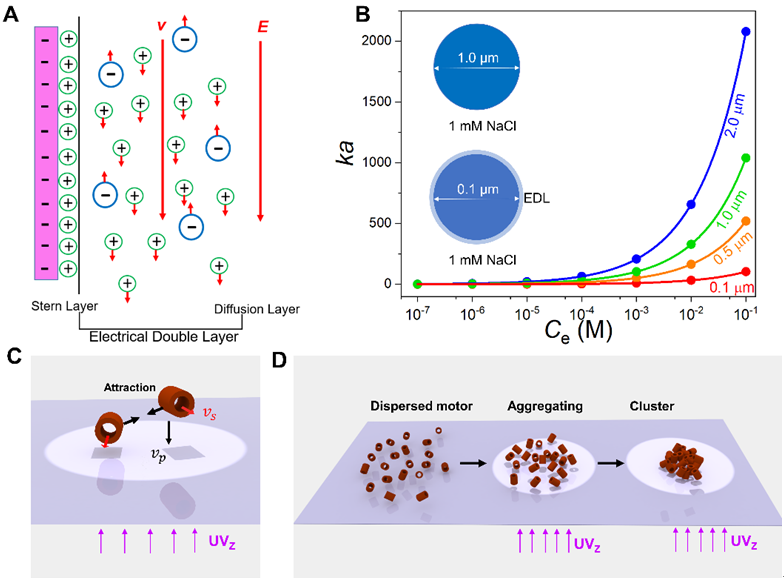热烈祝贺我团队于玲霞、牟方志等撰写的论文“Ultrasmall Fe2O3 Tubular Nanomotors: The First Example of Swarming Photocatalytic Nanomotors Operating in High-Electrolyte Media”被Nanomaterials(2022年IF:5.719,JCR1区期刊)接收!
化学驱动微纳米马达(MNMs)由于其自主特性和智能靶向运动行为(如趋化性和趋光性),在靶向药物运输、(生物)传感和环境修复方面表现出巨大的应用潜力。然而,这些MNMs的双电层厚度远少于其尺寸,导致其电泳驱动力易在高电解质浓度环境中显著降低甚至消失。本工作中,我们发现超细管状纳米马达可表现出高离子耐受的驱动行为和集群行为。在垂直向上的紫外线照射下,超细Fe2O3管状纳米马达(Fe2O3 TNMs)表现出增强扩散正趋光/重行为,并能可逆自组装形成纳米马达集群。自组装后,Fe2O3 TNMs表现出明显的群体行为,使其在基板附近从随机增强扩散运动转变为弹道驱动行为。即使在高电解质浓度(Ce)下,超细Fe2O3 TNMs仍保留了相对较厚的电双层(EDL),而EDL中的电渗透滑移流足以驱动它们并诱导产生泳动相互作用。因此,这些纳米马达在高电解质环境中也可以快速汇集到基板附近,继而聚集成可移动的纳米集群。这项工作将为高离子耐受化学纳米马达集群的设计提供新思路,并有望加快其在生物医学和环境修复中的应用。
原文摘要如下:Self-propelled chemical micro/nanomotors (MNMs) have demonstrated considerable potential in targeted drug delivery, (bio)sensing, and environmental remediation due to their autonomous nature and possible intelligent self-targeting behaviors (e.g., chemotaxis and phototaxis). However, these MNMs are commonly limited by their primary propulsion mechanisms of self-electrophoresis and electrolyte self-diffusiophoresis, making them prone to quenching in high electrolyte environments. Thus, the swarming behaviors of chemical MNMs in high-electrolyte media remain underexplored, despite their potential to enable the execution of complex tasks in high-electrolyte biological media or natural waters. In this study, we develop ultrasmall tubular nanomotors that exhibit ion-tolerant propulsions and collective behaviors. Upon vertical upward UV irradiation, the ultrasmall Fe2O3 tubular nanomotors (Fe2O3 TNMs) demonstrate positive superdiffusive photogravitaxis and can further self-organize into nanoclusters near the substrate in a reversible manner. After self-organization, the Fe2O3 TNMs exhibit a pronounced emergent behavior, allowing them to switch from random superdiffusions to ballistic motions near the substrate. Even at a high electrolyte concentration (Ce), the ultrasmall Fe2O3 TNMs retain a relative thick electrical double layer (EDL) compared to their size, and the electroosmotic slip flow in their EDL is strong enough to propel them and induce phoretic interactions among them. As a result, the nanomotors can rapidly concentrate near the substrate and then gather into motile nanoclusters in high-electrolyte environments. This work opens a gate for designing swarming ion-tolerant chemical nanomotors, and may expedite their applications in biomedicine and environmental remediation.



